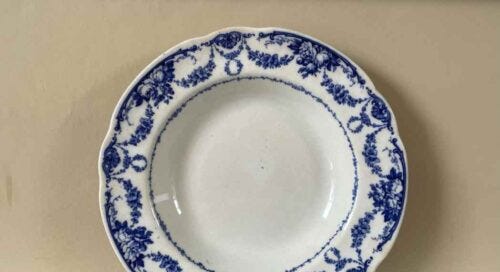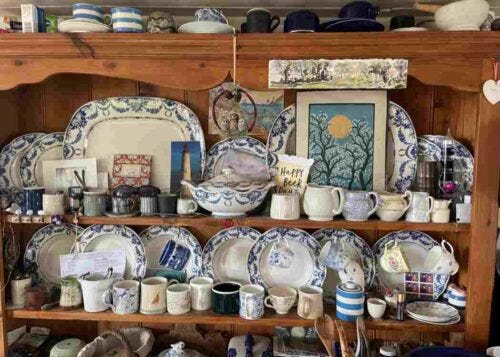At Turret Lodge, my grandmother’s house on Wandsworth Common, London, the front door was at the top of three wide steps. Wooden double doors – closed only at night – protected the inner door, with its ornate stained glass panel, and which opened onto the large hallway. Immediately to the right was the door to the kitchen, set on swinging hinges for the convenience of servants coming in and out with trays of food. When I idly looked up the current estate agent’s details, this room is identified as ‘Study’. What nonsense! To my mind, it will always be the kitchen.
It was a light and airy room, with large sash windows looking over the front garden and street, a substantial wooden table in the middle, and under the chimney breast the stove where Gracie used to sit. There was no sink or running water: along with the ancient gas cooker, these were in the dark little scullery to the rear. On one whole wall of the kitchen, ceiling to floor, was a built-in dresser, with drawers full of cutlery and kitchen implements, cupboards below and shelves above. On those shelves were arranged a complete dinner service of blue and white Wedgwood pottery: large dinner plates, smaller side plates, soup bowls, meat platters, serving dishes. The dinner service dominated the kitchen, but I don’t remember it ever being used – Turret Lodge and its residents had faded since its heyday as a family home, exhausted by age and the war. The younger generation, now middle aged, were off with their own families, leaving just Nanna, her sister Great Aunt Florence, Gracie, and a mysterious tenant on the top floor. We lived up the road, so we were in and out all the time, visiting on occasion for tea, but never for a formal dinner.
Big sister Ann remembered the house well, for she had lived there for much of World War II. She told me it was her sanctuary from parental control – Dad was away in the Air Force and Mum had too much to worry about for strict parenting. When Nanna died about ten years after the war and the house was cleared, Ann took possession of the dinner service. “Why would you want that, dear?” I can imagine my mother asking; but the faded Victoriana would have appealed to Ann and I suspect held important childhood memories. She not only kept it on display in her family home and London flat, she used it regularly. Then, in her later years, when she was rather faded after a stroke, it was again just a display on shelves in the hallway of her Clifton flat. And now that Ann has died the dinner service has passed on to her daughter Sarah, kept on her kitchen dresser. “I insist on using the plates”, Sarah told me when I borrowed the soup bowl to write this entry to Objects and Lives. “Even though the glaze is so worn. They must be kept out on the dresser, if you stack them in a cupboard, they go mouldy”.
The dinner service remains sharp in my memory. But as I write about it now, my mind is continually drawn to the dresser itself and the cupboards underneath, where one day Gracie showed me the little run, just wire netting over a crude wooden frame, in which she was keeping three or four baby chicks to raise indoors until they were big enough to go with the older chickens in the henhouse. They were just little bundles of yellow fluff, running up and down on spindly legs. And the chicks remind me of the henhouse in the corner of the garden, and how Gracie once picked the cat Tiddles up by the scruff of his neck when he got after the hens. Behind the henhouse was the working area where the gardener would have a bonfire, which he allowed me to poke it with a stick. And there was a long shed down the side of the house filled with old lawnmowers, rusty garden forks, spades, oil cans, and food safes with sliding doors made with perforated zinc. Oh, and the outdoor toilet with a London Telephone Directory hung on a nail to use as toilet paper. Not to speak of the cellar, with steps down from the scullery, dark and dusty, but still set up with the bunk beds and odds of furniture from when it was used as a bomb shelter.
Turret Lodge is advertised by the estate agents as an ‘imposing double fronted property’. The photos show it has been modernised and gentrified to within an inch of its life, made suitable for an aspiring twentieth-century upper middle-class family. I could be outraged at what they have done to my Nanna’s house with all its faded grandeur. But then I realize that my grandparents bought it when they themselves were an ‘aspiring upper middle-class family’. Turret Lodge continues in the role it was originally built for.





